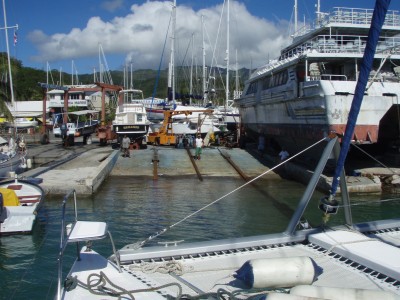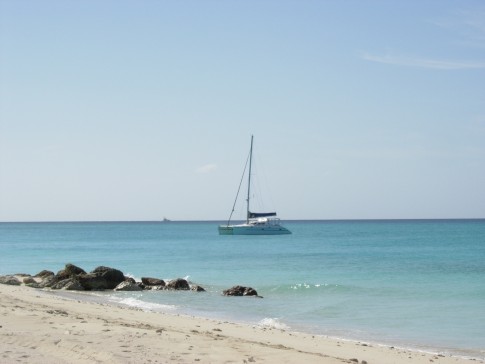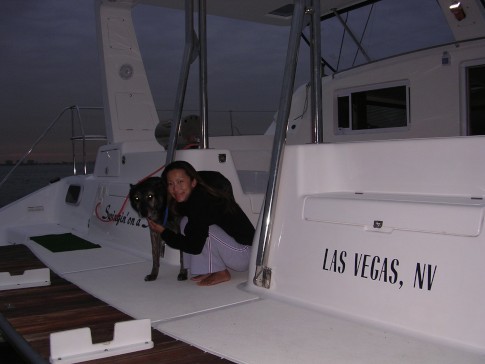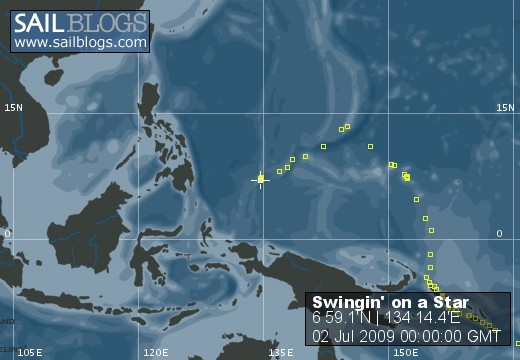
Swingin' on a Star
Ship's log for the circumnavigating Saint Francis 50 catamaran, "Swingin on a Star".
01 April 2010 | Palau
13 July 2009 | Palau
05 July 2009 | Yacht Harbor
03 July 2009 | Peleliu
02 July 2009 | Palau
01 July 2009 | Two Dog Beach
30 June 2009 | Mecharchar
29 June 2009 | Mecharchar
28 June 2009 | Ulong
27 June 2009 | Ngeruktabel
17 June 2009 | Ngeruktabel
16 June 2009 | Ngeruktabel
15 June 2009 | Ngeruktabel
14 June 2009 | Ngeruktabel
13 June 2009 | Ngerutable
25 May 2009 | Yacht Harbor
30 April 2009 | Malakal
29 April 2009 | Koror
28 April 2009 | Malakal
27 April 2009 | Malakal
The Rails of Raiatea
18 August 2008 | Raiatea
Randy

We got up at the crack of dawn this morning hoping to make Raiatea in time for an AM haul out. We raised our anchor and motored out of the sand bank into the Povai Bay. We decided to raise the main here. The winds were predicted to be light today, around 10 knots, and from the east. This would make exiting the pass, which is on the west side of the island, pretty easy. We left the jib put away until we got a better picture of the situation in the channel.
The pass was calm and we motored out and around toward the south side of Bora Bora. Once around the southwest point we made a direct line for the main western pass of Raiatea, just south of the Raiatea Carenage. This seemed to be exactly where the wind was coming from, as usual. We motored along at about 7 knots with the main helping some here and there.
It is about 21 miles from pass to pass and it took us the expected three hours with an hour on each side for negotiating the lagoons and passes. The channel between Raiatea and Bora Bora is protected from the southeast seas by Raiatea but anything from the south or southwest comes barreling right in. Fortunately there was little swell and the apparent wind never got over 20 knots. The Raiatea pass was well marked and eventless as was the lagoon transit.
We ended up on a mooring outside of the Carenage at about 10:00 but it was too late to haul until after lunch. We probably could have made it in the AM but we weren't sure we were in the right place. The Raiatea Carenage is right next to, and looks like the same facility as, Raiatea Marine. Raiatea Marine has a big sign on the roof that says "VHF channel 72". Unfortunately the person handling radio and pone for Raiatea Carenage didn't connect the dots when we described our location and the VHF 72 bit. After receiving some fairly suspect directions, along with a call back after lunch, we decided to stay on the mooring and get the hotel accommodations sorted out first.
We had called around a bit the prior week and settled on Raiatea Lodge. After touring Raiatea I can feel good about saying that it is the nicest place to stay on the island. They have a great little dock out front and the are a very short trip south from the Carenage, so Hideko and I just took the dinghy over.
We were greeted by Oliver, one of the owners, and shown to a lovely room with free wifi, hot water and aircon (no of these a given in FP). The grounds are lush and lovely and the hotel is a quaint boutique with only 16 rooms. It would be a prefect place for our week or two stay while Swingin' on a Star got her annual tune up.
Oliver explained to us that there are only two place that haul boats on Raiatea and both are right where we were parked. This information in hand we returned to the big boat and clarified things with the Carenage. We were indeed right in front of their shop, which is situated on the northwest side of Raiatea, between the main west side pass and the airport.
I had never done a rail system before so I was looking forward to the experience with a touch of trepidation. After our dinghy ride I noticed two hazards in the area. First, like many of the society island lagoons, the anchorages her are deep and many use moorings. There are moorings (most with boats) all around the area, and some don't necessarily clear the surface. Second there is a very shallow, as in above water at low tide, reef covering the entire south side of the Carenage ramp. In fact if you are south of track on the line into the ramp you will hit the rocks in anything but a dinghy.
I was on the radio with Dominic, who is the owner of the Carenage, and he talked me in. We approached north of the transit leading into the ramp. As we got over the rails I slowed the boat. I had to keep her moving a bit though because the wind was up a bit and we were pushing to the south. There were about four or five guys in the water and once close enough we quickly secured lines to the port bow and stern to keep the boat off of the reef. This involved a bit of hustling and some confusion as the guys working in the yard speak Tahitian and French.
Once the port lines were on we secured cross ties forward and aft, springs, and starboard lines. At this point I realized that there was no one in sight who could speak English. I continue to scold myself for not coming up to speed on other languages faster. I should really have conversational French down by now, but I don't. Nor Spanish. Nor Japanese, Nor Tahitian. Though bits of each are running through my head making things even more interesting.
Once secured to the car below the winch operator on shore begins to haul the car up the tracks. I noted that before things got moving my sounder read 2 feet. This really means a bit over three feet but I had still never seen the number 2 there before.
As the car moves forward it tows the boat through the water on the lines attached to it until the leading edge of the keel makes contact with the boards lashed to the car. At this point things stop and final adjustments are made to the boats position over the car through the lines. Once set they begin to actually haul the boat when the car advances. The winch is connected to the car via heavily greased cables on a 7:1 purchase, so things go nice and slow.
At some point in the process the keels go flat on the car. It you are lucky your boat will sit perfectly going up the grade this way. I doubt many have this luck. It is nice to have a balanced boat. For upwind sailing this means center of gravity in the middle of the boat, for downwind a lift aft of the middle. Regardless, most cats are going to be a little aft heavy. Even if they weren't lifting them at an angle would make them so. Point being most will pop a wheelie given the chance. We did.
The guys were swimming under the boat yelling at each other and I just have a vision of the trailing edges of the keels crunching down into the knotty wood of the slats mounted on the rusty metal of the rail car. I tried to discuss matters with one of the guys who spoke a tiny bit of English. He was not the senior guy and given the level of our discussion I was as likely to be misunderstood or misunderstand as to communicate. There was noting for it, so I put on a mask and jumped into the water.
The boat was definitely not sitting level on her keels. After a bit of discussion they blocked the starboard stern and continued hauling. I didn't like the look of things and almost had to start throwing things to get the winch operator to stop. "Stop" is apparently not the first English word in the course. After failing to communicate the need for blocks on the port and also failing to find Dominic, or any one else who spoke English, I decided to let them proceed as I watched the port side carefully. It was rocked way back on the keel bit not picking up at all like before. Two of the guys were actually hanging on the bow lines. I not sure what they thought this accomplished but I am very sure I didn't like it.
In the end she made it up to the top of the track without a problem. That said if I were to do it again I would require the following: 1) Someone who speaks English must be on station at all times during the haul out to communicate with the captain. 2) The port and starboard stern must be blocked in the water as soon as the keels are level on the car.
Careful? Definitely. Paranoid? Perhaps. Regardless, no one will be crying but you if a yard damages your boat. They also have to block the stern of your boat once it is at rest so why not just do it when it is most important, while the boat is moving up the track? After a rough opener I have come to have a strong respect for this yard, but more on that later.
It was late in the day by the time the car was locked in place at the top of the tracks and the boat was properly blocked. The railway setup here allows only one boat to be in port at a time. The rail can handle just about any 50 foot catamaran but I do know that they had to turn away a 60 footer. The rail could take her but there is a 100 foot steel power cat sitting in the yard right next to the rail that interferes with very wide (over 9 meter) boats. The power cat was a Maupiti shuttle that took a bit too much of a short cut one day and ended up on the reef.
Once everything was situated I grabbed an overnight bag and joined Hideko in the dink. It was a short 5 minute dinghy ride to Raiatea Lodge and a good nights sleep.
The pass was calm and we motored out and around toward the south side of Bora Bora. Once around the southwest point we made a direct line for the main western pass of Raiatea, just south of the Raiatea Carenage. This seemed to be exactly where the wind was coming from, as usual. We motored along at about 7 knots with the main helping some here and there.
It is about 21 miles from pass to pass and it took us the expected three hours with an hour on each side for negotiating the lagoons and passes. The channel between Raiatea and Bora Bora is protected from the southeast seas by Raiatea but anything from the south or southwest comes barreling right in. Fortunately there was little swell and the apparent wind never got over 20 knots. The Raiatea pass was well marked and eventless as was the lagoon transit.
We ended up on a mooring outside of the Carenage at about 10:00 but it was too late to haul until after lunch. We probably could have made it in the AM but we weren't sure we were in the right place. The Raiatea Carenage is right next to, and looks like the same facility as, Raiatea Marine. Raiatea Marine has a big sign on the roof that says "VHF channel 72". Unfortunately the person handling radio and pone for Raiatea Carenage didn't connect the dots when we described our location and the VHF 72 bit. After receiving some fairly suspect directions, along with a call back after lunch, we decided to stay on the mooring and get the hotel accommodations sorted out first.
We had called around a bit the prior week and settled on Raiatea Lodge. After touring Raiatea I can feel good about saying that it is the nicest place to stay on the island. They have a great little dock out front and the are a very short trip south from the Carenage, so Hideko and I just took the dinghy over.
We were greeted by Oliver, one of the owners, and shown to a lovely room with free wifi, hot water and aircon (no of these a given in FP). The grounds are lush and lovely and the hotel is a quaint boutique with only 16 rooms. It would be a prefect place for our week or two stay while Swingin' on a Star got her annual tune up.
Oliver explained to us that there are only two place that haul boats on Raiatea and both are right where we were parked. This information in hand we returned to the big boat and clarified things with the Carenage. We were indeed right in front of their shop, which is situated on the northwest side of Raiatea, between the main west side pass and the airport.
I had never done a rail system before so I was looking forward to the experience with a touch of trepidation. After our dinghy ride I noticed two hazards in the area. First, like many of the society island lagoons, the anchorages her are deep and many use moorings. There are moorings (most with boats) all around the area, and some don't necessarily clear the surface. Second there is a very shallow, as in above water at low tide, reef covering the entire south side of the Carenage ramp. In fact if you are south of track on the line into the ramp you will hit the rocks in anything but a dinghy.
I was on the radio with Dominic, who is the owner of the Carenage, and he talked me in. We approached north of the transit leading into the ramp. As we got over the rails I slowed the boat. I had to keep her moving a bit though because the wind was up a bit and we were pushing to the south. There were about four or five guys in the water and once close enough we quickly secured lines to the port bow and stern to keep the boat off of the reef. This involved a bit of hustling and some confusion as the guys working in the yard speak Tahitian and French.
Once the port lines were on we secured cross ties forward and aft, springs, and starboard lines. At this point I realized that there was no one in sight who could speak English. I continue to scold myself for not coming up to speed on other languages faster. I should really have conversational French down by now, but I don't. Nor Spanish. Nor Japanese, Nor Tahitian. Though bits of each are running through my head making things even more interesting.
Once secured to the car below the winch operator on shore begins to haul the car up the tracks. I noted that before things got moving my sounder read 2 feet. This really means a bit over three feet but I had still never seen the number 2 there before.
As the car moves forward it tows the boat through the water on the lines attached to it until the leading edge of the keel makes contact with the boards lashed to the car. At this point things stop and final adjustments are made to the boats position over the car through the lines. Once set they begin to actually haul the boat when the car advances. The winch is connected to the car via heavily greased cables on a 7:1 purchase, so things go nice and slow.
At some point in the process the keels go flat on the car. It you are lucky your boat will sit perfectly going up the grade this way. I doubt many have this luck. It is nice to have a balanced boat. For upwind sailing this means center of gravity in the middle of the boat, for downwind a lift aft of the middle. Regardless, most cats are going to be a little aft heavy. Even if they weren't lifting them at an angle would make them so. Point being most will pop a wheelie given the chance. We did.
The guys were swimming under the boat yelling at each other and I just have a vision of the trailing edges of the keels crunching down into the knotty wood of the slats mounted on the rusty metal of the rail car. I tried to discuss matters with one of the guys who spoke a tiny bit of English. He was not the senior guy and given the level of our discussion I was as likely to be misunderstood or misunderstand as to communicate. There was noting for it, so I put on a mask and jumped into the water.
The boat was definitely not sitting level on her keels. After a bit of discussion they blocked the starboard stern and continued hauling. I didn't like the look of things and almost had to start throwing things to get the winch operator to stop. "Stop" is apparently not the first English word in the course. After failing to communicate the need for blocks on the port and also failing to find Dominic, or any one else who spoke English, I decided to let them proceed as I watched the port side carefully. It was rocked way back on the keel bit not picking up at all like before. Two of the guys were actually hanging on the bow lines. I not sure what they thought this accomplished but I am very sure I didn't like it.
In the end she made it up to the top of the track without a problem. That said if I were to do it again I would require the following: 1) Someone who speaks English must be on station at all times during the haul out to communicate with the captain. 2) The port and starboard stern must be blocked in the water as soon as the keels are level on the car.
Careful? Definitely. Paranoid? Perhaps. Regardless, no one will be crying but you if a yard damages your boat. They also have to block the stern of your boat once it is at rest so why not just do it when it is most important, while the boat is moving up the track? After a rough opener I have come to have a strong respect for this yard, but more on that later.
It was late in the day by the time the car was locked in place at the top of the tracks and the boat was properly blocked. The railway setup here allows only one boat to be in port at a time. The rail can handle just about any 50 foot catamaran but I do know that they had to turn away a 60 footer. The rail could take her but there is a 100 foot steel power cat sitting in the yard right next to the rail that interferes with very wide (over 9 meter) boats. The power cat was a Maupiti shuttle that took a bit too much of a short cut one day and ended up on the reef.
Once everything was situated I grabbed an overnight bag and joined Hideko in the dink. It was a short 5 minute dinghy ride to Raiatea Lodge and a good nights sleep.
Comments
| Vessel Name: | Swingin' on a Star |
| Vessel Make/Model: | Saint Francis 50 |
| Hailing Port: | Las Vegas, NV |
| Crew: | Randy Abernethy |
| Home Page: | http://swinginonastar.com |
Swingin on a Star

Who: Randy Abernethy
Port: Las Vegas, NV






